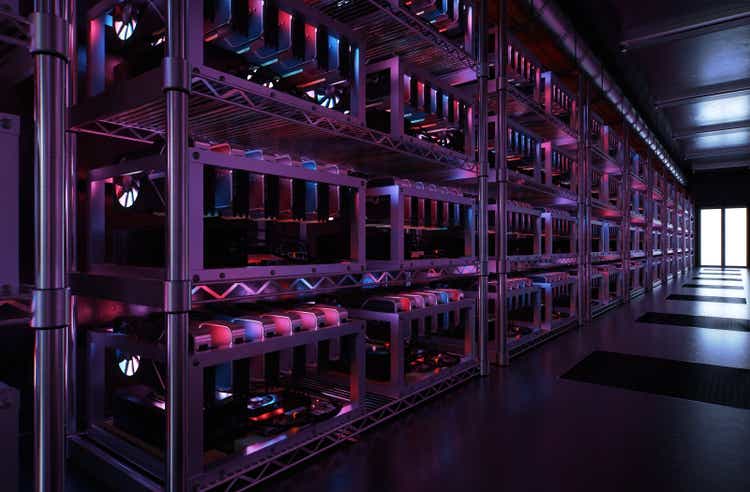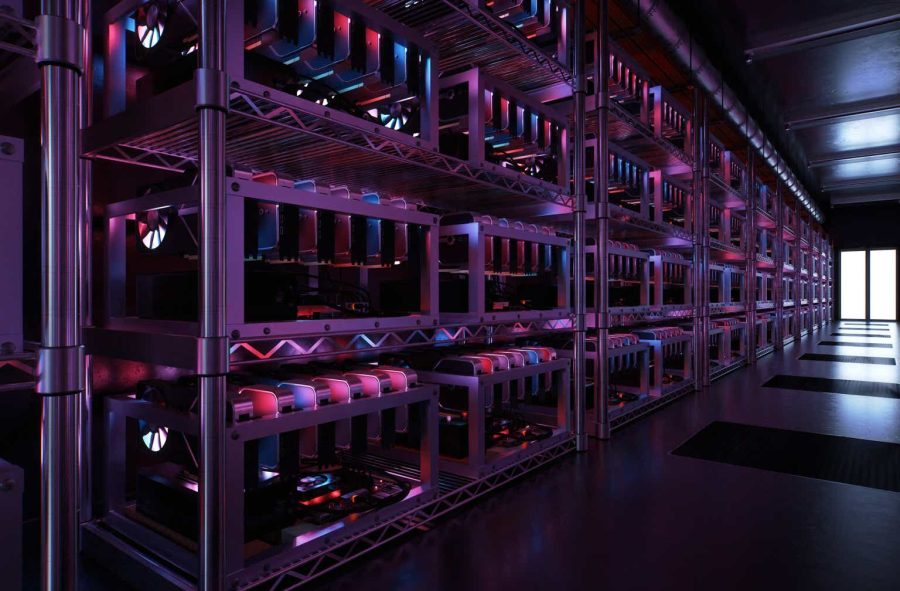Summary:
- Riot Platforms faces significant challenges, including Bitcoin halving, equity dilution, and EBITDA level losses, leading to a 60% stock decline year-to-date.
- Despite a strong balance sheet and aggressive expansion plans, Riot’s profitability remains uncertain due to the halving event, increasing network difficulty, and volatile Bitcoin prices.
- The company’s recent financial performance has been poor, with substantial operating losses and minimal operating cash flow, raising concerns about future profitability.
- Given the current market conditions and operational challenges, I recommend staying away from RIOT stock, although there may be short-term trading opportunities.
luza studios
Investment Overview
After a strong rally in the first quarter of 2024, Bitcoin USD (BTC-USD) has been sideways to lower. However, the digital asset is still higher by 24% for year-to-date. In comparison, it’s been a challenging year for Bitcoin miners. Riot Platforms, Inc. (NASDAQ:RIOT) stock has plunged by almost 60% year-to-date.
This coverage on Riot stock will discuss the reasons for the sharp correction and evaluate if the miner is worth considering. At a forward P/E of 24.4, Riot stock seems attractive. The company has ambitious growth plans through 2027.
However, it’s not enough to look at the growth ambitions. This thesis discusses the major concerns along with the positives. Overall, my view is that it makes sense to remain on the sidelines. However, for traders, there are likely to be opportunities for quick gains from oversold levels.
As a quick overview, Riot Platforms is a North American Bitcoin miner. As of August 2024, the company reported deployed and operational hash rates of 23.5EH/s and 14.5EH/s respectively.
Why Riot Stock Corrected?
The starting point of discussion is the reason for a deep correction in Riot stock even as Bitcoin has trended higher. In my view, there are four reasons for the downside.
First, Bitcoin’s halving might be good for investors in the long term. However, the halving event implies difficulty in mining and a significant increase in cost. Omid Malekan, an adjunct professor at Columbia Business School opines that “some miners will no longer be profitable, and they will stop mining.” This is likely with block rewards essentially cut into half and significant energy costs will impact margins. Riot is therefore in an uncertain zone and the coming quarters will provide further insight into the profit potential.
Second, in the second week of August, Riot filed for a $750 million controlled equity offering. This implies potential dilution in the coming months and has negatively impacted Riot’s stock. Earlier in February 2024, the company had entered a $750 million ATM offering. I must add here that in 2022, Riot pursued a $500 million at-the-market equity offering. Also, in 2023, the company had a $750 million ATM offering. It would be a different story if significant dilution translated into growth and robust cash flows. That has not been the case in the last few years.
Third, Bitcoin traded at a high of $73,800 on March 12, 2024. The cryptocurrency has, however, remained sideways to lower in the last few months and currently trades near $55,000. Even with the prospects of expansionary monetary policies, Bitcoin has not witnessed a sharp rally as seen in gold. After the halving event, Bitcoin needs to trade significantly higher from current levels for mining operations to deliver robust cash flows. Considering the volatility in digital assets, investors have been jittery about considering exposure to Riot stock.
Fourth, at the beginning of September, Riot announced a stake of 19.9% in Bitfarms Ltd. (BITF). The company has gradually increased its stake in Bitfarms. However, according to Riot, there has been a lack of engagement from Bitfarms. With the latter announcing the acquisition of Stronghold Digital Mining, Inc. (SDIG), it seems clear that the objective is to fend off Riot’s plans for a potential merger or acquisition. An open letter to Bitfarms shareholders is an indication of the point that Riot is in an awkward position. The acquisition of a 19.9% stake might not end well for Riot and its shareholders.
The key point I want to make here is that all these factors have contributed to the correction in Riot stock. However, the first three factors are an ongoing risk and are not limited to a few quarters. It remains to be seen if the positives outweigh these risks. In my view, the possibility is low.
Strong Fundamentals and Aggressive Expansion
Among the positive factors, the first point to note is strong fundamentals. As of Q2 2024, Riot reported cash and marketable securities of $639 million. Further, the company held 9,334 Bitcoins that were valued at $585 million. This implies a total cash buffer of $1.2 billion. I must add that Riot has a zero-debt balance sheet and financial flexibility is therefore high.
Having said that, the source of cash is not robust operating cash flows. Last year, Riot reported an OCF of $33 million, and the OCF in 2022 was less than a million. The cash buffer has therefore been built through dilution of equity. It’s not necessarily bad if the dilution provides a revenue and cash flow bump-up. That’s the key challenge with Bitcoin halving.
In terms of expansion plans, Riot reported a deployed hash rate of 23.5EH/s as of August 2024. As the chart below shows, the plan is to pursue aggressive hash rate capacity expansion in the next few years.
By the end of 2025, the capacity deployed will more than double to 56.6EH/s. I don’t see any financial challenges on the expansion front. Riot has a strong balance sheet and the controlled ATM will add to the cash buffer.
The big question, however, remains: Will hash rate capacity addition translate into EBITDA margin expansion and cash flow upside?
Let’s look at Q2 2024 numbers for some insight. For the quarter, Riot reported operating level loss of $117 million. This includes changes in the fair value of Bitcoin and derivative assets. Further, EBITDA and adjusted EBITDA loss for the quarter were $55 million and $75 million respectively. If I had a add a fifth reason for Riot stock correcting, it would be dismal numbers for Q2 2024. Of course, these numbers reflect the impact of difficulty in Bitcoin mining after the halving event.
There is a case for profitable operations if Bitcoin doubles from current levels. However, that’s the only assumption that makes a case for investing in Riot stock. When it comes to hash rate capacity expansion, MARA Holdings, Inc. (MARA), and Bitfarms, among others, have been aggressive. Therefore, it’s not just Riot that’s positioned to benefit from incremental capacity.
Also, an increase in hash rate does not necessarily imply an increase in the number of Bitcoin mined. Between June 2023 and June 2024, Riot increased its hash rate by 105.6%. However, the number of Bitcoin mined declined by 43.2%. Besides halving, an increase in network difficulty impacted growth. With the hash rate (global) likely to increase in the coming quarters, network difficulty will increase. This will negatively impact the mining numbers. To counter this challenge, the market share of the hash rate needs to increase. It’s not surprising that Riot has been pursuing acquisitions. In July 2024, Riot acquired Block Mining for a consideration of $92.5 million. This transaction has the potential to add 16EH/s of self-mining hash rate by the end of 2025.
Breakeven and Power Cost Challenges
In April 2024, Marathon CEO Fred Thiel opined that the firm’s breakeven rate would be $46,000 after the halving event. While it’s likely to differ for companies, it would be safe to assume that the breakeven would be in the range of $45,000 to $55,000 per Bitcoin.
With Bitcoin trading at $55,000, the operations would be hardly profitable. The first point therefore is that Riot is likely to report sluggish numbers for Q3 2024. This will ensure that Riot stock remains sideways to lower.
It’s important to note that Riot reported a direct cost to mine one Bitcoin of $25,327 for Q2 2024. For the same period, the Bitcoin mining gross margin was 62%. However, this non-GAAP gross margin includes $13.9 million in power curtailment credits. I would also look at the EBITDA margin rather than the gross margin to determine operating level profitability.
For Q2 2024, the average Bitcoin price was $66,071. Even at this price, Riot reported an adjusted EBITDA loss of $75.2 million. Having said that, the losses are exaggerated due to a change in the fair value of Bitcoin by $76.4 million. If this factor is eliminated, Riot Platforms would have an EBITDA level profit of $1.2 million. Riot was barely profitable at the EBITDA level with Bitcoin above $60,000. This underscores the view that EBITDA breakeven is likely above $50,000 even if we assume operating efficiency going forward.
Another interesting point to note is that securing cheap electricity for mining operations will be a bigger challenge. It’s estimated that the AI sector pays 3x to 4x more for electricity than U.S. Bitcoin miners. It’s expected that U.S. Data Centers will consume 9% of the country’s electricity generation by 2030. Considering the AI boom, I expect the breakeven for miners will continue to increase on the back of higher power costs.
Of course, Bitcoin has skyrocketed after each halving event. Between the halving of 2020 and 2024, the cryptocurrency has delivered 8x returns. However, hoping for an upside in Bitcoin would be a weak thesis for exposure to miners. It would make more sense to invest in Bitcoin or a Bitcoin ETF and consider miners if there is a significant rally from current levels for the digital asset.
Concluding Views
Riot Platforms has a strong balance sheet and is pursuing aggressive hash rate capacity expansion. However, beyond this, the thesis is dominated by concerns related to cost. I don’t see Riot delivering strong numbers in the coming quarters. That’s likely to keep sentiments bearish. Further, Bitcoin needs to surge higher for mining activity to be profitable. For now, the company is diluting equity for expansion, but it’s unlikely that operating cash flows will be robust.
If we look at the valuations, Riot stock trades at a forward EV/EBITDA of 5.4. There seems to be a valuation gap as compared to the industry metrics. It’s however important to note that a relatively low enterprise value is on the back of a debt-free balance sheet and solid cash buffer. Further, if Bitcoin trades around current levels, it’s likely that EBITDA estimates will be revised on the downside. While valuation metrics are important, I believe that the forward EV/EBITDA metric will change significantly in the next few quarters.
Amidst the concerns discussed, I would stay away from Riot stock. I believe that further downside is likely in the coming months. Of course, there can be trading opportunities from deeply oversold levels, but Riot is far from being a long-term investment idea.
Analyst’s Disclosure: I/we have no stock, option or similar derivative position in any of the companies mentioned, and no plans to initiate any such positions within the next 72 hours. I wrote this article myself, and it expresses my own opinions. I am not receiving compensation for it (other than from Seeking Alpha). I have no business relationship with any company whose stock is mentioned in this article.
Seeking Alpha’s Disclosure: Past performance is no guarantee of future results. No recommendation or advice is being given as to whether any investment is suitable for a particular investor. Any views or opinions expressed above may not reflect those of Seeking Alpha as a whole. Seeking Alpha is not a licensed securities dealer, broker or US investment adviser or investment bank. Our analysts are third party authors that include both professional investors and individual investors who may not be licensed or certified by any institute or regulatory body.

